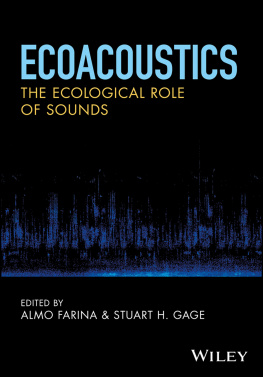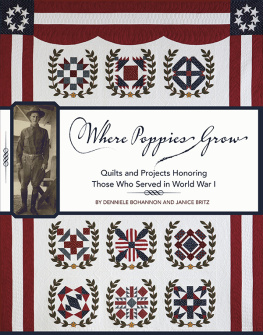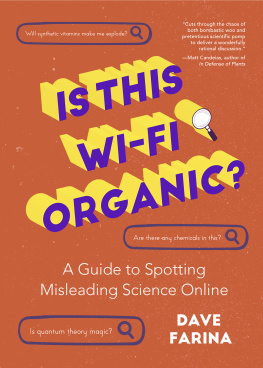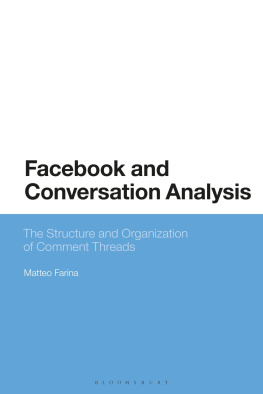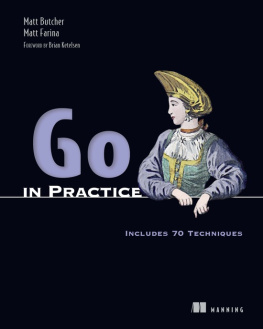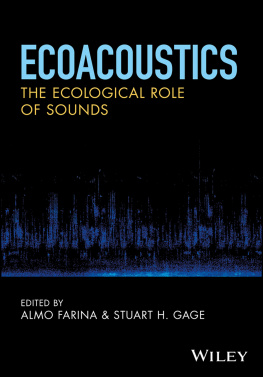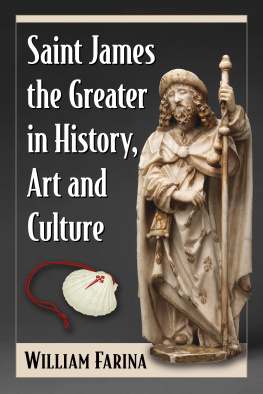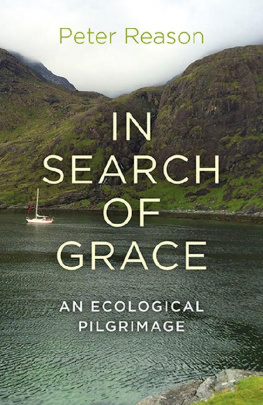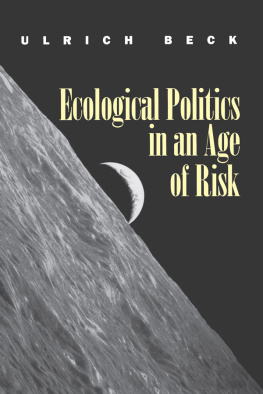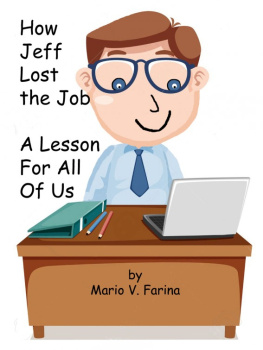Farina Almo - The Ecological Role of Sounds
Here you can read online Farina Almo - The Ecological Role of Sounds full text of the book (entire story) in english for free. Download pdf and epub, get meaning, cover and reviews about this ebook. year: 2017, genre: Romance novel. Description of the work, (preface) as well as reviews are available. Best literature library LitArk.com created for fans of good reading and offers a wide selection of genres:
Romance novel
Science fiction
Adventure
Detective
Science
History
Home and family
Prose
Art
Politics
Computer
Non-fiction
Religion
Business
Children
Humor
Choose a favorite category and find really read worthwhile books. Enjoy immersion in the world of imagination, feel the emotions of the characters or learn something new for yourself, make an fascinating discovery.
- Book:The Ecological Role of Sounds
- Author:
- Genre:
- Year:2017
- Rating:3 / 5
- Favourites:Add to favourites
- Your mark:
- 60
- 1
- 2
- 3
- 4
- 5
The Ecological Role of Sounds: summary, description and annotation
We offer to read an annotation, description, summary or preface (depends on what the author of the book "The Ecological Role of Sounds" wrote himself). If you haven't found the necessary information about the book — write in the comments, we will try to find it.
The Ecological Role of Sounds — read online for free the complete book (whole text) full work
Below is the text of the book, divided by pages. System saving the place of the last page read, allows you to conveniently read the book "The Ecological Role of Sounds" online for free, without having to search again every time where you left off. Put a bookmark, and you can go to the page where you finished reading at any time.
Font size:
Interval:
Bookmark:

This edition first published 2017
2017 John Wiley and Sons
All rights reserved. No part of this publication may be reproduced, stored in a retrieval system, or transmitted, in any form or by any means, electronic, mechanical, photocopying, recording or otherwise, except as permitted by law. Advice on how to obtain permission to reuse material from this title is available at http://www.wiley.com/go/permissions.
The right of Almo Farina and Stuart H. Gage to be identified as the authors of this work/the editorial material in this work has been asserted in accordance with law.
Registered Offices
John Wiley & Sons Inc., 111 River Street, Hoboken, NJ 07030, USA
John Wiley & Sons Ltd, The Atrium, Southern Gate, Chichester, West Sussex, PO19 8SQ, UK
Editorial Office
9600 Garsington Road, Oxford, OX4 2DQ, UK
For details of our global editorial offices, customer services, and more information about Wiley products visit us at www.wiley.com.
Wiley also publishes its books in a variety of electronic formats and by print-on-demand. Some content that appears in standard print versions of this book may not be available in other formats.
Limit of Liability/Disclaimer of Warranty:
While the publisher and authors have used their best efforts in preparing this work, they make no representations or warranties with respect to the accuracy or completeness of the contents of this work and specifically disclaim all warranties, including without limitation any implied warranties of merchantability or fitness for a particular purpose. No warranty may be created or extended by sales representatives, written sales materials or promotional statements for this work. The fact that an organization, website, or product is referred to in this work as a citation and/or potential source of further information does not mean that the publisher and authors endorse the information or services the organization, website, or product may provide or recommendations it may make. This work is sold with the understanding that the publisher is not engaged in rendering professional services. The advice and strategies contained herein may not be suitable for your situation. You should consult with a specialist where appropriate. Further, readers should be aware that websites listed in this work may have changed or disappeared between when this work was written and when it is read. Neither the publisher nor authors shall be liable for any loss of profit or any other commercial damages, including but not limited to special, incidental, consequential, or other damages.
Library of Congress Cataloging-in-Publication Data
Names: Farina, Almo, editor. | Gage, S. H., editor.
Title: Ecoacoustics : the ecological role of sounds / edited by Almo Farina, Urbino University, IT, Stuart H Gage, Michigan State University, East Lansing, MI, US.
Description: First edition. | Hoboken, NJ : John Wiley & Sons, Inc., 2017. | Includes bibliographical references and index.
Identifiers: LCCN 2017003603 (print) | LCCN 2017005379 (ebook) | ISBN9781119230694 (cloth) | ISBN 9781119230700 (pdf) | ISBN 9781119230717 (epub)
Subjects: LCSH: Landscape ecology. | Nature sounds. | Bioacoustics. | Ecosystem health. | Biodiversity.
Classification: LCC QH541.15.L35 E247 2017 (print) | LCC QH541.15.L35 (ebook) | DDC 577-dc23
LC record available at https://lccn.loc.gov/2017003603
A catalogue record for this book is available from the British Library.
Cover Design: Wiley
Cover Image: Courtesy of Stuart H. Gage
- Anne C. Axel
- Department of Biological Sciences
- Marshall University
- Huntington
- USA
- Giuseppa Buscaino
- BioAcousticsLab
- National Research Council (IAMC-CNR) - Detached Unit of Capo Granitola (TP)
- Italy
- Maria Ceraulo
- Department of Pure and Applied Sciences
- University of Urbino
- Urbino
- Italy
- Almo Farina
- Department of Pure and Applied Sciences
- University of Urbino
- Urbino
- Italy
- Francesco Filiciotto
- BioAcousticsLab
- National Research Council (IAMC-CNR) - Detached Unit of Capo Granitola (TP)
- Italy
- Susan Fuller
- Queensland University of Technology
- Brisbane
- Australia
- Stuart H. Gage
- Department of Entomology
- Michigan State University
- East Lansing
- USA
- Wooyeong Joo
- Choongnam
- Seocheon-gun
- Maseo-Myeon
- Geumgang-ro
- South Korea
- Eric P. Kasten
- Michigan State University
- East Lansing
- USA
- Bernie Krause
- Wild Sanctuary
- Glen Ellen
- USA
- David Monacchi
- Conservatorio Gioachino Rossini
- Pesaro
- Italy
- Timothy C. Mullet
- Ecological Services
- US Fish and Wildlife Service
- Daphne
- Alabama
- USA
- Brian Michael Napoletano
- Centro de Investigaciones en Geografa Ambiental
- Universidad Nacional Autnoma de Mxico
- Morelia
- Michoacn
- Mxico
- Susan E. Parks
- 107 College Place
- Syracuse
- USA
- Gianni Pavan
- CIBRA
- University of Pavia
- Italy
- Nadia Pieretti
- Department of Pure and Applied Sciences
- University of Urbino
- Urbino
- Italy
- Marisol A. Quintanilla-Tornel
- Plant and Environmental Protection Sciences
- University of Hawaii
- Manoa
- USA
- Lyndsay Rankin
- Northern Illinois University
- DeKalb
- USA
- Denise Risch
- Scottish Association for Marine Science (SAMS)
- Oban
- Scotland
- UK
- Michael Towsey
- Queensland University of Technology
- Brisbane
- Australia
Discovering the importance of sound in natural processes is an important legacy of bioacoustics and human acoustics, two disciplines that have developed in the second half of the twentieth century. At that time, Aldo Leopold and Rachel Carson used acoustics to describe relevant phenomena like animal migration or the effect of chemical pollution on reproductive success of breeding birds but acoustics technology methods were rare. Their heritage is an important baseline for a new ecological perspective in the scientific investigation of sound, known as ecoacoustics, a discipline that incorporates and integrates the study of sound in both ecological and human systems.
Sound is an important phenomenon including behavioral functions that range from mate performance to territory defense and social cohesion and has recently been shown to be a key issue in ecological processes. The Earth emits geological, biological, and human sounds within the biosphere, creating a sonic context that characterizes ecosystems at different spatial and temporal scales and has consequences that can affect many ecological processes. Vocal animals have a direct relationship with habitat suitability and the vocal performance of other organisms, further confirming the energy investment required to produce acoustic signals and the trade-off between such performances, other life traits, and the availability of resources needed for their survivorship.
Next pageFont size:
Interval:
Bookmark:
Similar books «The Ecological Role of Sounds»
Look at similar books to The Ecological Role of Sounds. We have selected literature similar in name and meaning in the hope of providing readers with more options to find new, interesting, not yet read works.
Discussion, reviews of the book The Ecological Role of Sounds and just readers' own opinions. Leave your comments, write what you think about the work, its meaning or the main characters. Specify what exactly you liked and what you didn't like, and why you think so.

